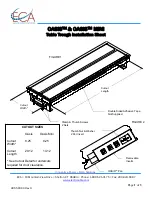
Operating the R&S
QAR
R&S
®
QAR
37
User Manual 1178.7200.02 ─ 04
areas in more detail. For more information about working with the mask, see
The mean reflection indicates the radar transparency of the DUT. The lower the mean
reflection, the better the radar transparency of the DUT. A higher mean reflection
results in beam refraction, increased transmission loss and standing waves between
the DUT and the radar sensor. For optimal radar compatibility, the DUT's mean reflec-
tion has to be minimized.
The reflection's standard deviation indicates the homogeneity of the DUT. Inhomogene-
ous DUTs alter the incident wave's phase fronts, cause angle errors, blind spots and
increased side lobes. For optimal radar compatibility, the DUT's reflection standard
deviation has to be minimized.
5.1.3.3
Transmission Measurement
Because the incident signal is split in a reflected and a transmitted part, it is of interest
to measure not only the reflection but also the transmission properties.
Measuring the transmitted signal, requires the optional transmitter module that is loca-
ted behind the DUT (on the DUT table). The transmitter uses 64 discrete frequency
points to cover a selected frequency span between 72
GHz and 82
GHz. This allows
for an exact evaluation of the DUT's transmission frequency response.
The frequency response yields detailed information regarding the RF transmission loss
of the DUT at the exact frequency band intended for radar operation. This is therefore
independent of the actual signal waveform utilized by the radar unit, which facilitates
the testability and optimization of the radome itself.
The transmission diagram shows the frequency response of the DUT. The minimum
and maximum values indicate the degree of frequency matching achieved by the DUT.
Ideally, the minimum of the frequency response is located at the operating frequency
range of the radar sensor that is to be used in combination with the DUT. Shifted min-
ima indicate issues with the DUT's electrical thickness.
The R&S
QAR calculates the one-way mean attenuation for specific frequency ranges
(76
GHz to 77
GHz and 76
GHz to 81
GHz). The results are displayed below the dia-
gram in logarithmic units (dB).
The one-way mean attenuation is calculated as follows:
-20
·
log
10
(mean transmission coefficient)
The mean transmission coefficient is calculated over the respective frequency range.
5.1.4
Configuration
The R&S
QAR provides several tools to configure the radome measurement.
Radome Measurements
















































